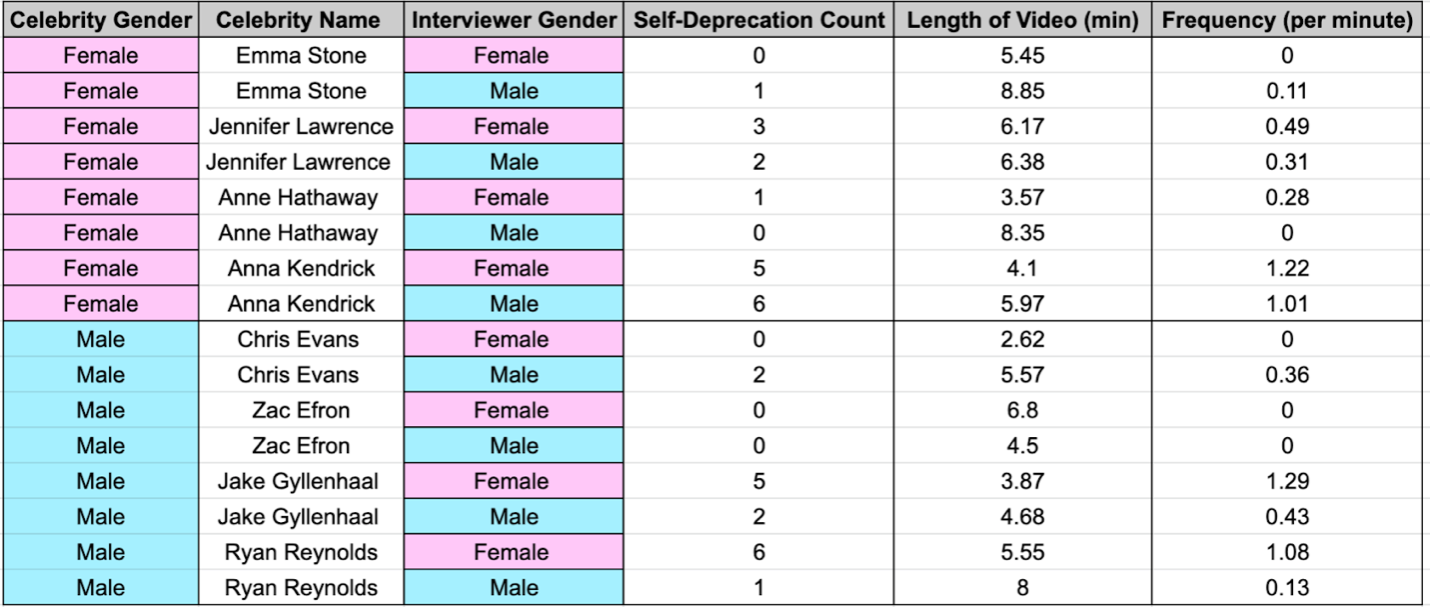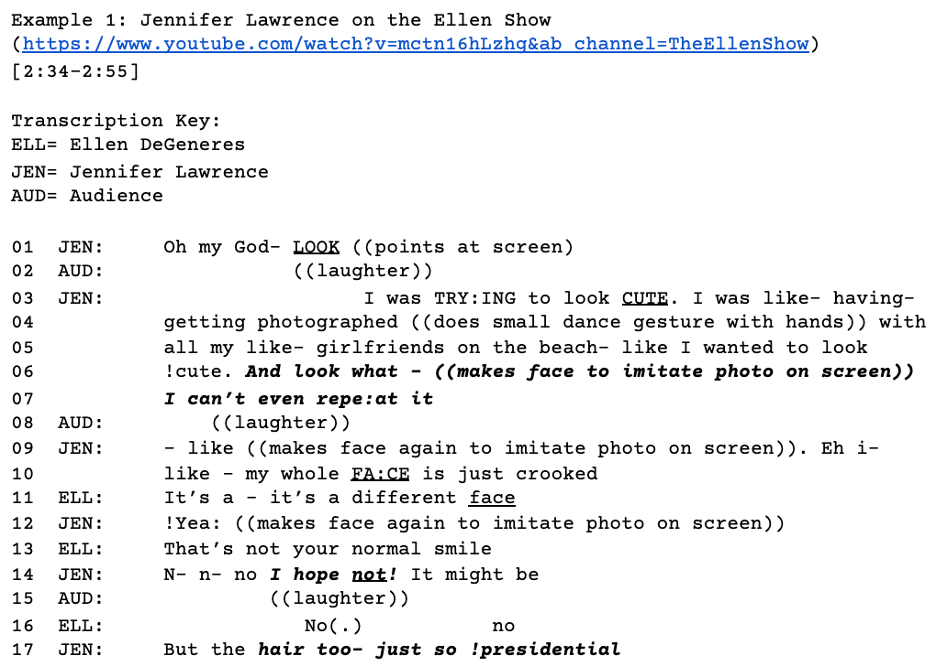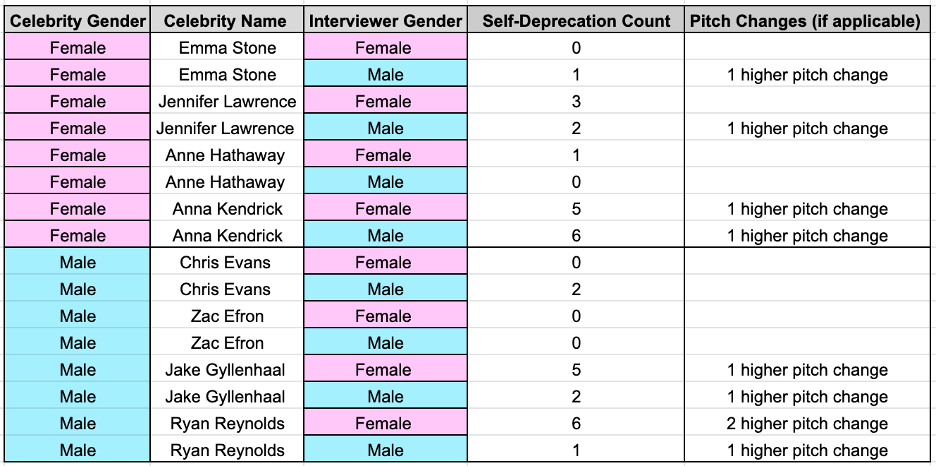Sapna Ramappa
Why and how do people use self-deprecation? Do people use it to “fish for compliments” or just seem more relatable? This article highlights the prevalence and utilization of self-deprecating language among actors and actresses in interviews on late-night talk shows. Interviews with four female celebrities and four male celebrities on The Ellen Degeneres Show and The Tonight Show Starring Jimmy Fallon were analyzed in order to discern any potential gender differences in the intentions and execution of self-deprecation that celebrities employ. Accounts of self-deprecation were sorted into categories of self-deprecation (physical appearance, professional/intellectual competence, personality traits, and behavior) and pitch alterations (higher or lower pitches). Ultimately, this study found that the use of self-deprecation is not as gendered as previously thought, which could illuminate how being a public figure in an industry that is quick to scrutinize one’s physical appearance and performance can influence the ways in which people perceive themselves and speak about themselves.
Introduction and Background:
Just as self-affirmation can inspire individuals to strive for healthy and positive behaviors, self-deprecating language can potentially also affect the ways that we perceive ourselves and others (Epton & Harris, 2008). Self-deprecating humor is a valuable tool employed by comedians to show humility and lightheartedness (Speer, 2019). But who tends to use this form of humor more often and for what purpose?
In previous studies, female comedians have been found to use self-satire more often than their male peers (Russell, 2002). This humor serves as a non-threatening way to make the comedian more “acceptable” and “appropriate” by placing herself as the joke itself. However, self-deprecation is not just limited to making fun of one’s physical appearance. People use self-deprecating humor directed at their behaviors, personality traits, intellectual/professional abilities, social status, success, or physical appearance (Greengross & Miller, 2008). However, there are no existing studies that reveal gender differences in the categories of self-deprecation use. The findings of this project can provide more insight on how men and women are socialized to behave and view aspects of their own identity.
Men and women may also differ in the ways that they use self-deprecating humor; male speakers have been found to use a higher pitched voice when using humor and female speakers have been found to use a lower pitched voice when compared to their normal voices (Purandare & Litman, 2006). This study, which analyzed the use of self-deprecation in male and female celebrities on late-night television interviews, suggests that there are no significant gender differences in how often celebrities use self-deprecation and the “professional/intellectual competencies” and “physical attractiveness” categories. However, there are gender differences in the “behaviors” and “personality traits” categories and the ways the celebrities use pitch changes.
Methods:
This study analyzed interviews with male and female celebrities on two late-night talk shows, The Ellen DeGeneres Show and The Tonight Show Starring Jimmy Fallon. The female actresses analyzed were Jennifer Lawrence, Emma Stone, Anne Hathaway, and Anna Kendrick, and the male actors analyzed were Chris Evans, Zac Efron, Jake Gyllenhaal, and Ryan Reynolds, for a total of 16 interviews. The study looked at celebrity gender, interviewer gender, the count of self-deprecating humor used, the category of self-deprecation, and the presence and/or type of pitch change used in self-deprecating humor. Self-deprecation accounts were identified and categorized if the celebrities used any negative statements towards themselves with regards to the four categories: “behaviors”, “personality traits”, “professional/intellectual competencies”, or “physical attractiveness”. Pitch changes were identified if the celebrities used a drastic and extremely noticeable higher or lower pitch while using self-deprecating language. Frequencies of self-deprecation were then calculated to compare self-deprecation in relation to celebrity interviewee gender, categories of self-deprecation, and pitch changes.

Results and Analysis:
Frequencies/Counts of Self-Deprecating Humor:


Throughout all interviews, female celebrities used 18 accounts of self-deprecation with an average frequency of 0.43/minute and male celebrities used 16 accounts with an average frequency of 0.41/minute. The frequency difference between female and male celebrities was 0.02, which indicates that there is no significant gender difference here.
Categorizations of Self-Deprecating Humor:


The evidence shows that there is no significant gender difference in the “professional/intellectual competence” and “physical appearance” categories, but there are gender differences in the “behavior” and “personality traits” categories. Women use more self-deprecation about their behaviors and men use more self-deprecation for their personality traits.

This is a clear example of self-deprecation in the “physical appearance” category: Jennifer Lawrence makes fun of her appearance (specifically her face, her smile, and her hair) on a specific photo in Lines 6-7, Line 14, and Line 17.
Pitch Change Used for Self-Deprecating Humor:

Both female and male interviewees only utilized higher pitch changes when evoking self-deprecating humor.

Though the pitch change count looks similar in female (4) and male interviewees (5), male celebrities used higher pitch changes in 31% of self-deprecation accounts whereas female celebrities only used higher pitch changes in 22% of the time.

In this example, Ryan Reynolds uses an animated voice and higher pitch when saying the word “vest”, to make fun of what he was wearing.
Discussion and Conclusions:
The study did not find significant gender differences in the frequency of self-deprecation used in this sample of actors and actresses. Additionally, men and women both used similar amounts of self-deprecation when speaking about their professional/intellectual success and their physical appearance. There are several reasons why this may be.
This study solely analyzed self-deprecation used by actors and actresses, so their career path (given the cut-throat nature of Hollywood) may create an environment where they place a lot of value in how they look and how they perform, thus impacting how they speak about themselves. Celebrities are placed to a near superhuman standard of beauty and their physical appearance is often on display for the public to openly criticize, so celebrities may be more inclined to point out their own flaws before the public does so. The use of self-deprecation in the “professional/intellectual” category may be more gender-neutral, considering that all celebrities want to achieve success. Additionally, because these interviews are used to humanize celebrities, self-deprecation may be used to help establish rapport between the guests, interviewers, and celebrities; this tool can help them come across as relatable, humble, and likeable. Though there were gender differences in the “personality traits” and “behavior” categories, it is unclear whether these categories are too similar to be separated or if there are actual gender differences in the use of “behavior” as a constructed aspect of identity and “personality traits” as an essential aspect of identity. Due to potential differences in the topics of the interviews themselves, it must be noted that certain interviewees may have had more opportunities to use self-deprecating humor, which could skew the results.
When assessing pitch changes, the study found that they were used quite sparingly among men and women (the proportion of pitch changes used in all accounts of self-deprecation was 22% in women and 31% in men). However, all of the pitch changes across genders were higher pitch changes, which contradicts earlier findings that showed that women switch to a lower pitch when using humor (Purandare & Litman, 2006). Because the subjects studied are professional actors and actresses, they may not be modulating their pitch as much in an interview setting when compared to their normal discussions or while acting.
Ultimately, the similarities between male and female celebrities in the frequency and in the “physical appearance” and “professional/intellectual competency” categories of self-deprecation indicate that male and female celebrities have similar aspects of their identities that they choose to self-criticize. These analyses can provide greater insight on what it means to be a public figure in an industry that places enormous importance on success and physical appearance.

References:
